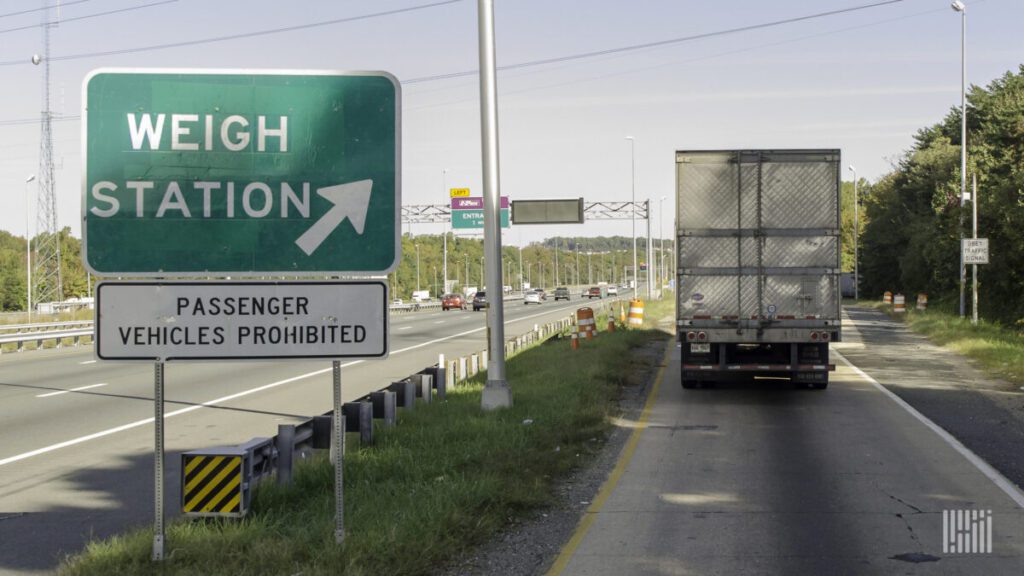February 9, 2023
How you can prepare to ace a weigh station inspection

Prep work begins long before the scales
Weigh station inspections can take as little as thirty minutes or, if a driver is having a bad day, it can end up costing them 10 hours.
Of course, 10 hours is only if a driver receives a violation severe enough to put them out of service.
These violations cost drivers not just their time but could require them to pay fines and impact the Pre-Employment Screening Program (PSP) report, which might make it more difficult to get hired by another carrier in the future.
But passing an inspection isn’t complicated, according to Robert Kaferle and Brian Runnels, both vice presidents of safety at Reliance Partners. The two shared tips drivers can implement to successfully pass weigh station inspections, drawing on their years of experience both behind the wheel and in the safety office.
When it comes down to it, in most circumstances drivers can prevent violations. One of the best — and most basic — things drivers should do while at a scale is to ensure they’re obeying the rules.
Though it may seem obvious, simple regulations are often unintentionally broken at weigh stations because a driver is focused on gathering paperwork and speaking with a law enforcement officer.
“It’s as simple as keeping your hands on the steering wheel until the officer approaches, keeping your prescription glasses and seat belt on so the officer can see. Then, if you need to take off your seatbelt or remove your prescription glasses to read paperwork, you should verbally tell the officer what you’re going to do,” Kaferle said.
Inspections are classified from Levels 1 through 6, but most of the time drivers will experience a Level 3 inspection. The Commercial Vehicle Safety Alliance states that Level 3 inspections focus on an “examination of the driver’s license; medical examiner’s certificate and skill performance evaluation (SPE) certificate; driver’s record of duty status; hours of service; seat belt; vehicle inspection reports; and a carrier’s identification and status.”
Drivers should be careful of violating form and manner regulations, which can be overlooked but are easily avoidable, like forgetting to add a bill of lading number on logs, missing trailer and tractor numbers and unclaimed driving time.
These violations may be seen as a red flag that could lead to more rigorous Level 2 (walk-around) or Level 1 (full) inspections.
“Eliminating simple things will put you in a better position to successfully get through an inspection. If they do a Level 3 and there’s nothing there, then they may not do a Level 2 or a Level 1 inspection,” Kaferle said.
In addition to following all rules, keeping the truck clean and in working order with no mechanical issues helps to avoid inspections in the first place.
“Don’t let trash build up on the dash and don’t have broken pieces of equipment. Visible disorganization could signal to an officer that there may be other potential issues with the truck,” Runnels noted.
To truly be prepared, however, prep work should begin well in advance of the scales. This starts with self-accountability.
A driver shouldn’t, and doesn’t have to, guess at remembering his or her violation and crash history. Kaferle recommends drivers request a PSP report once a year to know for sure what details are viewable.
PSP reports contain the last three years of roadside inspections and five years of crash history.
“As a driver, you make your living off your license to drive a tractor-trailer, so it’s critical to make sure it’s in a good standing,” Kaferle said.
Drivers should ensure all necessary paperwork is in the vehicle; the best practice is for drivers to bring any letters or paperwork from the state confirming any updates affecting their licenses, such as after yearly physicals.
“If you do get pulled over and the officer says, for example, ‘the state doesn’t have a copy of your current medical card,’ you can show them the letter that says it does,” Kaferle said.
Finally, drivers should make sure any other unrelated issues are taken care of, especially any pending legal issues, which might come back to haunt them.
“We see a ton of violations for drivers that have their CDL suspended for non-safety-related issues and many times that’s something to do with a court — whether it’s child support or fines. The very first thing they’ll go after is the driver’s license,” Runnels said.
Drivers should also be aware of their employers’ Inspection Selection System score, which makes some carriers more likely to get pulled aside for an inspection than others.
For carriers, Runnels offers this advice: “Once they start pulling more and more of your trucks, there are more opportunities for violations to be found and you get into a pattern that makes it difficult to get out of. Make sure your drivers are doing pre-trips, that their logs are in order and they’re doing loads legally. That goes a long way of keeping everyone out of the crosshairs.”